In today’s Throwback Thursday, we will take a look at how we covered the Yarnell Hill Fire that killed 19 members of the Granite Mountain Hotshot crew. We began writing the article at 6:15 p.m. MDT, June 30, 2014 and continued updating it through July 5. Like our other articles about fires that are updated over a period of days, it had the most recent updates at the top. However, for ease of reading, we put it in chronological order below.
****
(Originally published at 6:15 p.m. MDT, June 30, 2013)
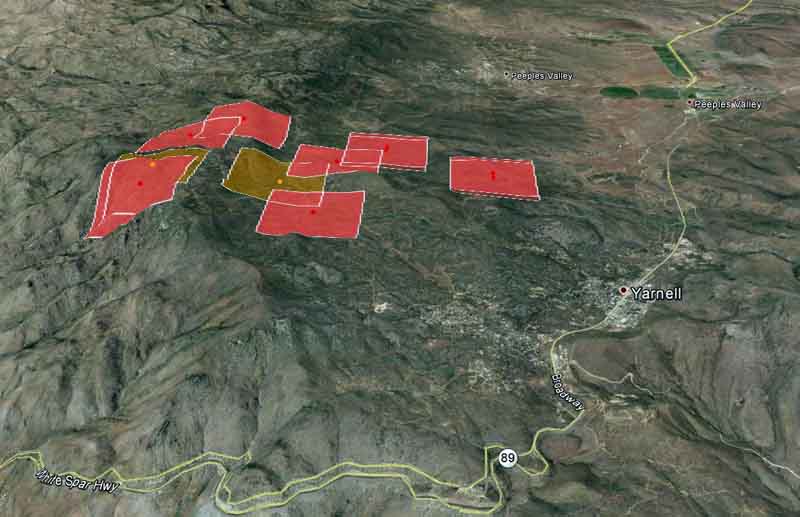
The Yarnell Fire has been burning for about 48 hours and already a Type 1 Incident Management Team, Clay Templin’s, has been ordered. A Type 3 IMTeam (Hall) had assumed command at 10 a.m. Sunday [June 30].
As you can see on the map above, at 11:55 a.m. MDT Sunday the fire appeared to be about a mile from Yarnell, Arizona, which is 26 miles southwest of Prescott. However the icons representing heat can be as much as a mile in error. The Southwest Area Coordination Center reports the fire has burned 800 to 1,000 acres.
ABC15 occasionally has live video of the fire, but for the short time I watched it, before it went to nothing but commercials, it was only showing helicopter footage of extreme closeups of flames, providing no context. The TV station is reporting 1,500 acres have burned forcing the evacuation of 600 people.
Jeffrey Blackburn has several photos of the fire, including the one below.
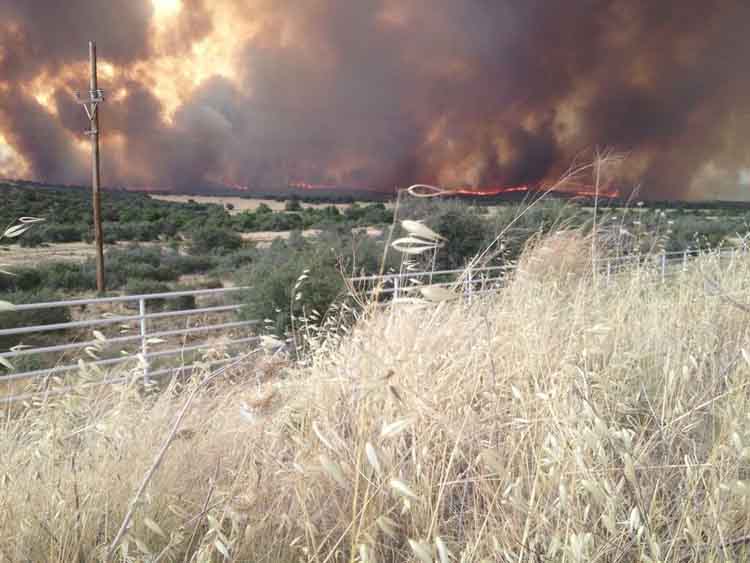
The nearby Stanton weather station recorded temperatures Sunday afternoon [June 30] up to 103 degrees and a low relative humidity of 14 percent. The forecast for Monday is more moderate, with a high temperature of 91 degrees, relative humidity around 20 percent, and 3-9 mph winds out of the southwest.
****
(UPDATED at 7:58 MDT, June 30, 2013)
At 6:55 p.m. MST @ArizonaNewsnet reported “The fire has engulfed the town of Yarnell. Multiple structures burning.”
This was apparently caused by a 180-degree shift in the direction of the wind. From 10 a.m. until 4 p.m. local time at the Stanton RAWS weather station four miles south of the fire, the wind was from the south-southwest or southwest, but at 5 p.m. it began blowing from the north-northeast at 22 to 26 mph gusting up to 43 mph. This may have pushed the fire into the town.
If there were any firefighters on the south or southwest side of the fire between 4 and 5 p.m., who previously had the wind at their backs for seven hours with the fire moving away from them, they may have suddenly and unexpectedly found the fire heading toward them at a rapid rate. Wind direction changes like this are sometimes caused by a passing thunderstorm with strong outflowing downdrafts.
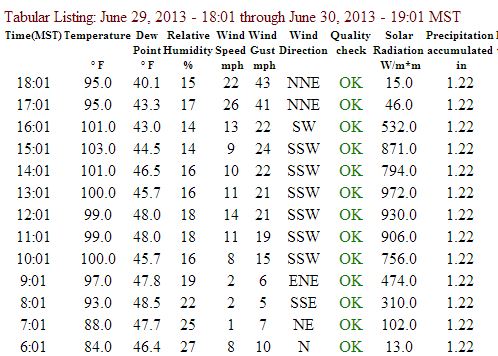
As of about 6 p.m. MDT a 15-mile stretch of US State Route 89 was closed.
“@wildfirediva” had information about air tankers:
We’ve got 3 Large Airtankers loading at Prescott, 2 VLATs loading at IWA & 4 SEATs loading at Wickenburg all for #YarnelHillFire #AZFire
6:11 PM – 30 Jun 2013
Note: “IWA” is Phoenix-Gateway airport.
Three medical helicopters are responding to Yarnell Fire Station, according to Arizona News Net:
Arizona News
@ArizonaNewsnet
#YarnellHill Fire: Multiple burn patients. Landing zone for medical helicopters at Yarnell Fire Station. #azfire
6:42 PM – 30 Jun 2013
At 7:08 p.m. smoke was preventing the helicopters from landing at Yarnell, @AZcentral reports. They are landing at Morristown Fire Station (between Phoenix & Wickenburg) to rendezvous with ground ambulances.
****
(UPDATED at 8:23 p.m. MDT, June 30, 2013)
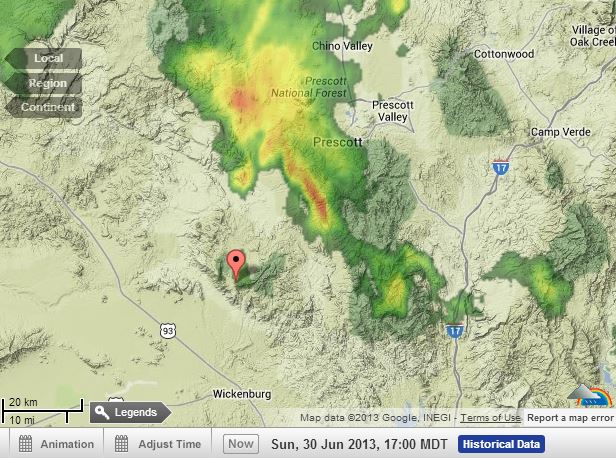
The radar map above, from WeatherUnderground, shows a thunderstorm cell north and northeast of the fire at Yarnell, Arizona. The pointer is at Yarnell. The cell was moving toward the southwest, and may have produced strong winds that changed the wind direction by 180 degrees (see below [above]) and could have been part of the reason the fire moved into Yarnell. It also could have caught firefighters by surprise.
****
(UPDATED at 8:52 p.m. MDT, June 30, 2013)
Several media outlets are reporting that the fire spread into the community of Yarnell, burning hundreds, about half, of the structures.
The time-lapse video below shot by Matt Oss on June 30, 2013 at 4:00 p.m. south of the fire near highway 89.
****
(UPDATED at 9:35 p.m. MDT, June 30, 2013)
There are reports that at least 18 firefighters were killed on the Yarnell Fire in Arizona. More details are in a separate article.
Here, we will continue to cover the Yarnell Fire itself as well as the reports of the numerous structures that burned., but the injuries and/or fatalities will be covered in the other article.
****
(UPDATED at 11:30 p.m. MDT, June 30, 2013)
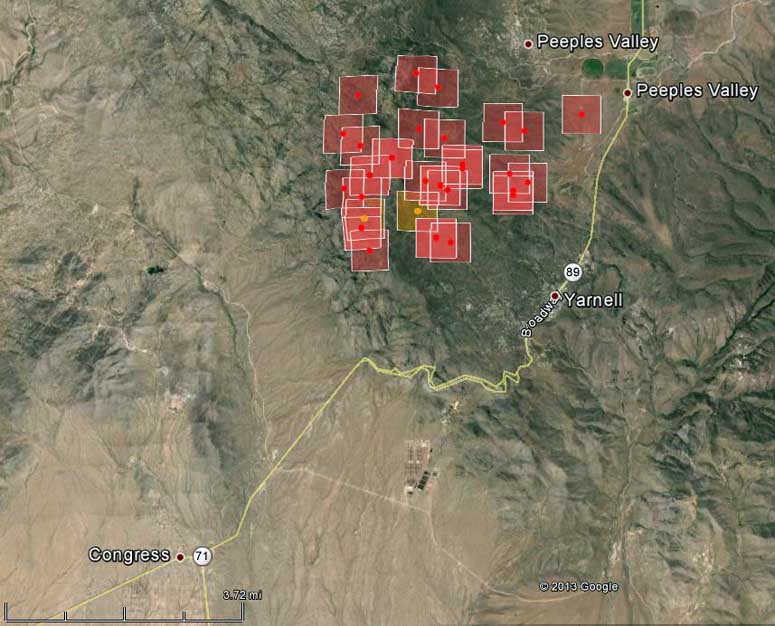
The map above shows heat detected by a satellite at 3:10 p.m. MDT, June 30. This was an hour or two before the wind direction changed 180 degrees and suddenly pushed the fire to the south into the town of Yarnell.
****
(UPDATE at 1:46 p.m. MDT, July 1, 2013)

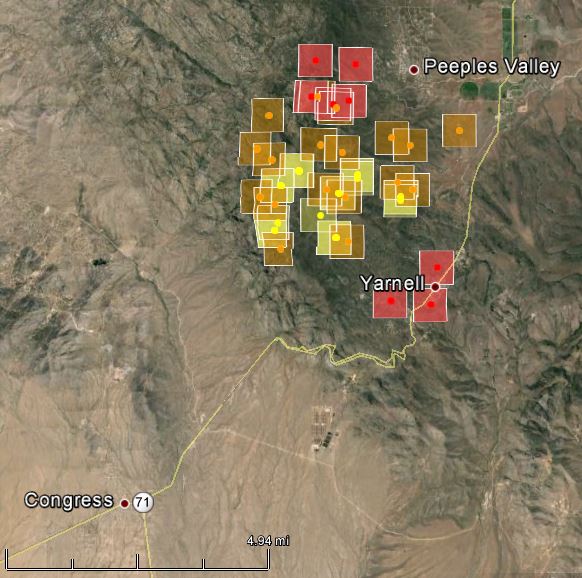
The maps of the Yarnell Fire above show heat, represented by the square icons, detected by a satellite at 3:10 a.m. MDT, July 1, 2013. The red squares were the most recently detected. All of the icons can be as much as a mile in error.
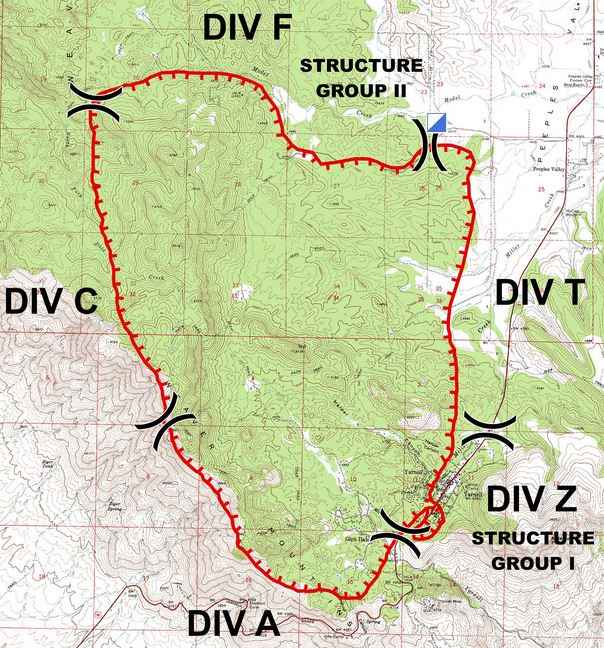
The Incident Management Team reports the fire has burned 8,374 acres and has zero containment. They also officially confirmed on Monday [July 1] morning the fatalities that occurred on Sunday:
A fire crew had to deploy their fire shelters late yesterday afternoon after strong winds pushed the fire to their position and 19 firefighters died in the line of duty.
Mike Reichling of the Arizona Forestry Division said the early report of about half the structures in Yarnell being destroyed in the fire is an exaggeration. He said the Yavapai fire chief was assessing the destruction.
A Type 1 Incident Management Team will assume command of the fire at or before 6:00 p.m. on Monday. Currently the Arizona Type 2 incident Management Team is directing operations with: 18 engines, 18 fire crews, 8 support water tenders, 2 crash/rescue vehicles, 2 structure protection vehicles, and 4 dozers. On order are more 20-person hotshot crews, type 2 hand crews, and other firefighting personnel and equipment.
****
(UPDATE at 7:30 p.m. MDT, July 1, 2013)
The Incident Management Team reports that an estimated 200 homes and other structures burned Sunday in Yarnell. The Yarnell Fire Department will continue to assess the damage Monday.
The New York City Fire Department is sending five members of their Incident Management Team to assist in managing the Yarnell Fire.
****
(UPDATE at 3:02 p.m. MDT, July 2, 2013)
During the 11:27 a.m. overflight today, the MODIS satellite did not detect any large concentrations of heat larger than 30 meters square on the Yarnell Hill Fire, but there could still be a lot of work left for firefighters, including constructing fireline. With so much uncompleted line, there is still the possibility for the fire to continue to spread.
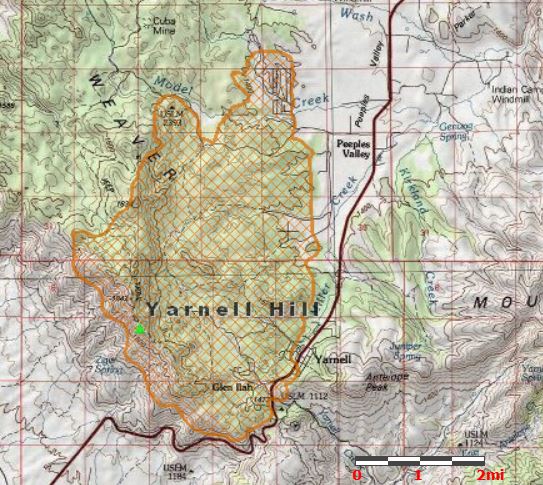
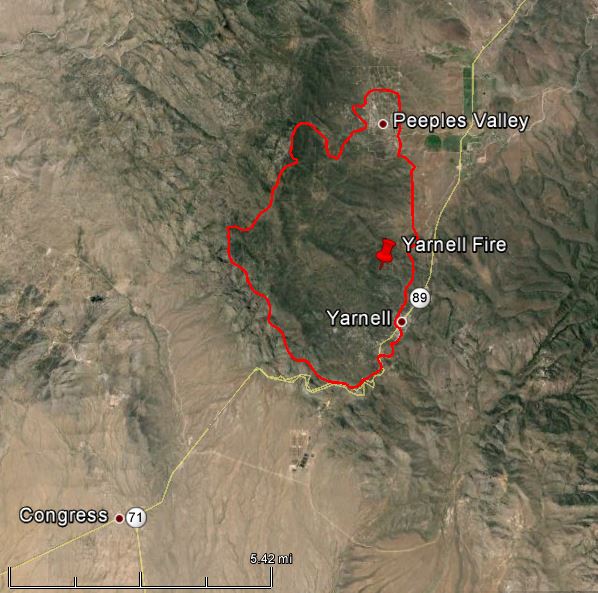

The Yarnell Hill Fire was less active Monday [July 1] than it was on Sunday [June 30] when it rapidly overran the position of the Granite Mountain Hotshots, killing 19. (More information about the fatalities.)
Air tankers and firefighters worked the north perimeter of the fire where it continued to spread, and 5 helicopters assigned to the fire dropped water on hot spots in support of the firefighters. Efforts continued to secure the east flank to protect other homes at risk.
The Incident Management Team reported that 50 primary structures have burned in the fire. As of 9:30 p.m. on Monday they said it had blackened about 8,400 acres, was zero percent contained, and was being fought by about 500 personnel.
Clay Templin’s Type 1 Incident Management Team assumed command of the fire at 6 p.m. Monday.
Fire officials will hold Community Meetings on July 2: 11 a.m. at Wickenburg High School and 3:30 p.m. at the Prescott High School.
****
(UPDATE at 7:50 a.m. MDT, July 3, 2013)
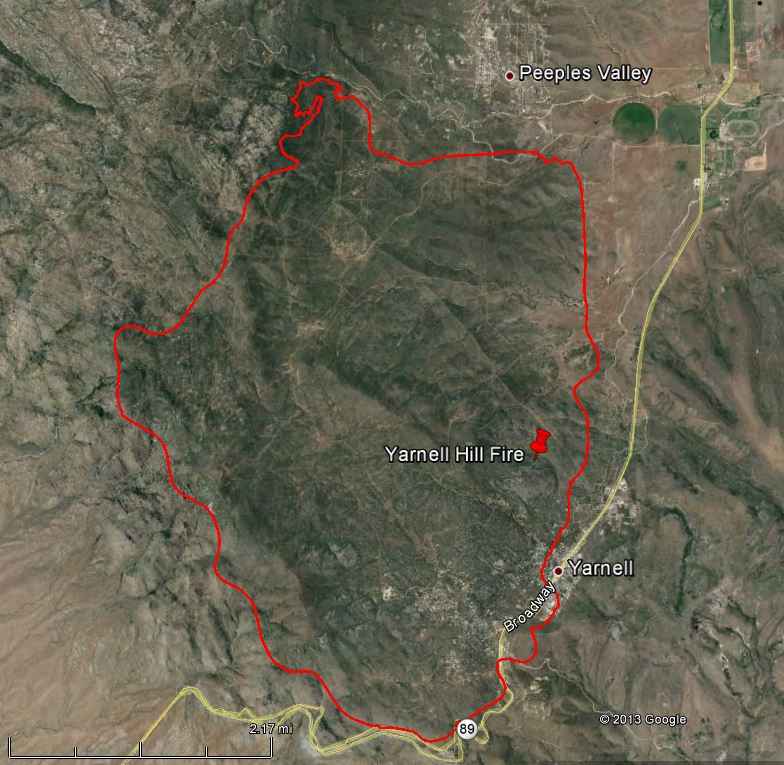
The Yarnell Hill Fire spread very little Tuesday and the Incident Management Team kept the reported acreage the same, at 8,400. The MODIS satellite detected no concentrations of heat larger than 30 meters across when it overflew the fire at 12:20 a.m. Wednesday. The IMTeam is estimating that 50 primary structures have burned, but this number may still be revised after assessments are complete. Approximately $1.75 million has been spent on the fire so far.
The Team selected 8 percent as the containment percentage they are distributing to the public. Until late yesterday they said there was no containment, meaning no fire line had been constructed and held. Until a few years ago, the containment percentage was an actual statistic, the amount of fire line completed and held compared to the fire line that still needed to be built, but recently it has become politicized and meaningless. There may still be some IMTeams that accurately report containment, and hopefully the IMTeam managing this fire is one of them. But since the public has no way of knowing, there is no point in getting excited about a containment percentage figure. More information about describing a fire as contained, controlled, or out is at the National Wildfire Coordinating Group’s web site.
Below is an excerpt from an update issued by the IMTeam Tuesday night at 10 p.m.:
Today, firefighters made good progress on the northeast corner and the fire perimeter near Yarnell. Two hot shot crews scouted the western flank until the threat of thunderstorms caused them to move to safer areas. Creeping and smoldering continued around the structures, primarily in the afternoon, and some areas around structures are still holding enough heat to be a concern. A plan is being developed to restore utilities and infrastructure to the affected communities. Contingency lines were scouted in case the fire becomes active again. Tonight, crews will be patrolling in the developed areas and working on flareups and visible heat.
****
(UPDATE at 7:30 p.m. MDT, July 3, 2013)
State Highway 89 remains closed between Date Creek Road south of Yarnell to mile marker 283 north of Peeples Valley.
There are 596 personnel assigned to the fire, including eight crews, 44 engines, and 9 helicopters.
The MODIS satellite found no concentrations of heat when it overflew the fire at 12:25 p.m. Wednesday. It can detect heat sources larger than 30 meters across.
Wednesday evening the Incident Management Team said the fire is 45 percent contained. This is a jump from the 8 percent number they were using yesterday. (But, refer to our explanation below about containment percentages.) The number of acres has not changed for a couple of days, and remains at 8,400.
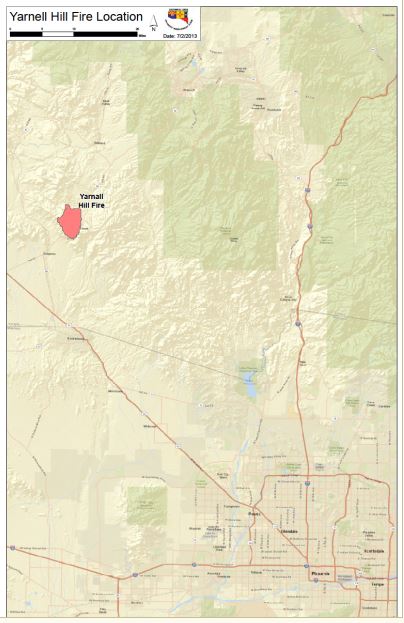
The IMTeam had not released a map of the fire since July 1, until they released the one above today. HERE is a link to a larger version of the map.
****
(UPDATE at 9:35 a.m. MDT, June 5, 2013)
Firefighters are making good progress on the Yarnell Hill Fire. Two maps released yesterday show the exact perimeter in detail and where fireline had been constructed when the maps were made on July 3. Today the IMTeam is calling the fire 80 percent contained. One of the maps says it has burned 8,165 acres, which is a revision from the 8,400 figure that has been used for several days and is still shown on InciWeb.
Evacuation orders were lifted for residents of Peeples Valley at 6:30 p.m. on Thursday, July 4. Only residents with valid identification will be allowed access into the community.
Residents needing information regarding the status of their properties can contact the Yavapai County Sheriffs Office at 928-427-6475.
We have more information about the deaths of the 19 firefighters and the weather that appeared to be a factor in the tragedy.

Dolores’s Tweet was the first indication I had that something very big was unfolding.